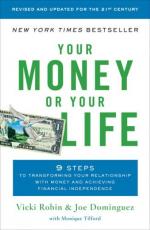
|
| Name: _________________________ | Period: ___________________ |
This test consists of 15 multiple choice questions and 5 short answer questions.
Multiple Choice Questions
1. What are some good alternatives to buying what is needed?
(a) Borrowing, trading, and sharing.
(b) Trading, sharing, and retiring.
(c) Sharing, trading, and stealing.
(d) Begging, stealing, and borrowing.
2. The wall chart's time span is a rough deadline for what?
(a) Finding a new career.
(b) Finding a life purpose.
(c) Retirement.
(d) Achieving financial independence.
3. Participants should always remain conscious of what?
(a) All the job opportunities around them.
(b) Life energy.
(c) Impending retirement.
(d) Inflation.
4. What is a major advantage of separating employment from passion?
(a) Jobs that do not inspire passion usually pay more.
(b) Passion won't be used as a substitute for experience.
(c) It is better to remove emotion from gainful employment.
(d) A greater variety of employment options becomes available.
5. What can cause some people to stop buying any extras at all, after starting to use the wall chart?
(a) Shock at their spending habits.
(b) Shock over actual income.
(c) Running out of room on the wall chart.
(d) Desire to change thier life purpose.
6. Why do people feel very free when volunteering?
(a) Because they do not have to be there, and can do things their way.
(b) Volunteering requires no skill.
(c) Volunteer work is unpaid.
(d) Volunteering can lead to job offers.
7. Where should monthly investment income be tracked?
(a) On a new chart.
(b) On the income and expense charts created in Chapters 2 and 3.
(c) On the wall chart.
(d) On reports from investment brokers.
8. Statistically, how many Americans are overweight?
(a) Two-thirds.
(b) Half.
(c) Three-fourths.
(d) One-third.
9. If "work" is different from "paid employment," then which of the following is true?
(a) Cleaning is only work when it's done by a paid professional.
(b) Volunteer jobs are not work.
(c) Work includes anything people do to provide a service, including cleaning the house.
(d) Retirement is the absence of work.
10. How many credit cards should program participants keep?
(a) One for business use, one for personal use, and one for emergencies.
(b) One for everyday use and one for emergencies.
(c) One, to be used only in emergencies.
(d) None.
11. What is Step 6?
(a) Determining net worth.
(b) Creating a wall chart.
(c) Minimizing spending.
(d) Planning for retirement.
12. In the 101 SURE WAYS TO SAVE MONEY section, what do the authors advise people to do in order to save on housing?
(a) Consider non-traditional housing.
(b) Avoid non-traditional housing.
(c) Buy and manage multiple rental properties.
(d) Buy a larger home as a hedge against inflation.
13. What mistake do people often make, when describing their jobs?
(a) Saying uncomplimentary things about thier supervisors.
(b) Playing down their true talents.
(c) Identifying themselves by their careers.
(d) Revealing annual income.
14. If people invest more money each month, what happens to the monthly interest?
(a) The interest increases each month.
(b) The interest decreases each month.
(c) The interest must be withdrawn from the account.
(d) The interest becomes tax-deductible.
15. How does the realization that not all work is paid add life to retirement?
(a) People who do not work after retirement have fewer health problems.
(b) Retired people are happy because they no longer work.
(c) People who do not work after retirement live longer.
(d) Retired people know they can still be useful.
Short Answer Questions
1. What are two tips for reducing transportation expenses?
2. How does eating a proper diet make sense financially?
3. Where do the authors recommend finding job-hunting advice?
4. What is the true definition of work?
5. What is one advantage of estimating the likely timing of the crossover point?
|
This section contains 667 words (approx. 3 pages at 300 words per page) |

|




